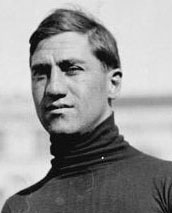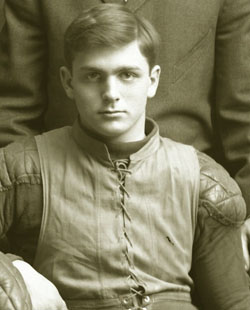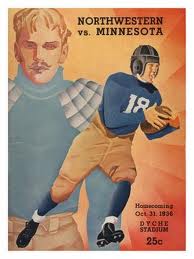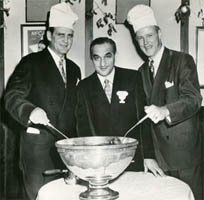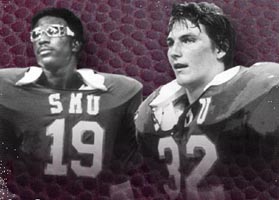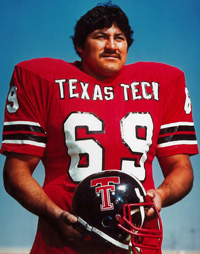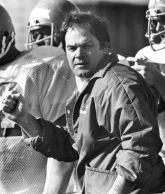Streak
Busters Archive - I
This
feature discusses a game in which a winning or losing or bowl streak
ended.
1905: Michigan @ Chicago
In the early years of the Western Conference (today's Big Ten), the big game was the annual Thanksgiving Day clash between Michigan and Chicago. The 1905 game at Chicago's Marshall Field attracted more interest than any game west of Philadelphia ever had before. Both teams were undefeated. The Maroons of Amos Alonzo Stagg were 9-0. Fielding Yost's Wolverines were not only 11-0 but had not been scored on all season. Their closest games were 12-0 over Wisconsin and 18-0 over Vanderbilt. Furthermore, Michigan had not lost since the last game of the 1900 season when Chicago won 15-6. Yost, who took over for the 1901 season, had never lost in his 65 games as head coach in Ann Arbor. Only a 6-6 tie at Minnesota in 1903 blemished his record. Included in the streak was a 49-0 trouncing of Stanford in the first Rose Bowl on January 1, 1901. Yost's teams had scored 2,746 points to 40 for their opponents!
Chicago enlarged its seating to accommodate 27,000 spectators but could have sold twice that many tickets. 3,000 UM fans journeyed by train to sit in the west stand supposedly reserved for them only to find another 3,000 Chicago fans there too. The crowd included large numbers of women who rooted as enthusiastically as the men.
An estimated $50,000 had been bet on the contest. Scalpers, mostly Chicago students, received upwards of $20 per ducat. Walter Camp, considered the "Father of American Football" and creator of the annual All-American teams, had traveled from Yale for the contest. In a precursor to the rooftop bleachers across the street from Wrigley Field, some fans paid to watch from temporary stands atop houses across Ellis Avenue.
Chicago president William Harper, despite being bedridden with the cancer that would take his life in several months, supervised the preparations for the big clash in detail. However, his plan to watch from his son's room in Hitchcock Hall across the street from the stadium didn't materialize because he was too weak that day. Instead, his son described the game to him by telephone.
 Chicago
Chicago-Michigan 1905 The game unfolded on a cold (10 degrees) gray day with light snow falling intermittently. The two finely-tuned machines played as close a game as any two teams could without tying. The first half devolved into a punting duel between Chicago's All-American sophomore QB Walter Eckersall (12 punts) and John Garrels of Michigan (10 boots). The Maroons crossed midfield three times, the Wolverines only once.
At halftime, Harper sent his nurse to the locker room to deliver a personal message encouraging the team. Stagg added his personal plea to win one for their president.
Early in the third quarter, Chicago was backed up inside its ten by a UM punt and a penalty. Then came the key play of the game, which didn't seem all that important at the time but ultimately led to the only points of the afternoon. Back to punt, Eckersall evaded the rushers and scampered for a first down on the 22. After three more firsts, the drive stalled, and Eckersall punted across the goal line from where William Clark tried to run it out. However, he was hit hard just after crossing the goal line and driven back across the goal line for a safety. (There was as yet no end zone.) This proved to be the only score of the game. Michigan punted nine times in the second half to Chicago's ten. The Maroons gained 139 yards to UM's 128.
After the game, 2,500 Chicago students and alumni formed an impromptu parade. Led by the band, they marched to President Harper's house and sang the Alma Mater. The celebration continued the next day with a bonfire accompanied by "a nightshirt parade and dance." On Monday night, the university staged an official celebration of the "Big Nine" championship called the "Monster Football Mass Meeting." Numerous alumni, particularly former players, assembled with the students.
Meanwhile, Wiliam Clark was pilloried as the goat who ended Michigan's streak. Camp himself described the ill-advised attempt to run out the punt as "a rank blunder." One newspaper declared: "Clark of Michigan defeated his own eleven." Clark left the team after the game and was missing for a time. He was quoted as saying, "This is horrible. ... I shall kill myself because I am in disgrace." He didn't do so at the time but finally did shoot himself in the heart seven years later. A suicide note to his wife expressed hope that his "final play" would atone for his blunder that cold Thanksgiving Day at Marshall Field.
The 1905 UM-Chicago game was in many ways the end of an era. Although the game itself did not provide any examples of brutality and serious injury, winds of change soon swept through college football, involving even the president of the United States. Rules changes made the game less hazardous and tried to regulate a spectacle that many university presidents and faculty believed was threatening the academic integrity of their institutions. One of the casualties of the reform movement was the Thanksgiving Day UM-Chicago clash. The two universities did not meet on the gridiron again until 1918. In that same year, Michigan began playing an annual game with Ohio State.
Reference: Michigan-Chicago 1905: The First Greatest Game of the Century
Thomas Edison video from Michigan-Chicago game of 1904
1947: Southern @ GramblingWhen Eddie Robinson became head coach at Grambling in 1946, the rural school in north central LA had never beaten Southern of Baton Rouge on the gridiron. There were many reasons for this.
- Southern had started its football program in 1915 while Grambling didn't begin until 1926. So when the schools started playing each other in 1933,Southern won the first three games by a combined 93-0.
- Southern University, considered by some as the Harvard of Southern black colleges, was started by the Louisiana legislature in 1880 in New Orleans and moved to Baton Rouge in 1914.
- Founded in 1901 as an agricultural school, Grambling State was a quasi-public institution for many years, not becoming a four-year college until 1943.
- "They were the big school and the most powerful in the Southwestern Athletic Conference (SWAC)," Robinson said of the Baton Rouge school coached by one of the early giants of black football, "Ace" Mumford, for whom Southern's stadium is named.
- The series had aspects of a class war: the more sophisticated, better educated blacks of Southern vs the country blacks from Grambling.
- A Baton Rouge native, Robinson said, "Southern used to treat Grambling like the little brother. There were times when they were not interested in playing us." To add to the disparity, most of the administrators and professors at Grambling were Southern grads.

 L: Eddie Robinson; R:A.W. Mumford Robinson lost his first Southern game in 1946, 38-0. He used Southern as the benchmark to measure the improvement of his program. He also knew that his Tigers would probably have to defeat the Jaguars multiple times to earn an invitation to join SWAC.
When the Tigers defeated the Jaguars 21-6 in 1947, "they were really upset," said Robinson. "As far as games go, that 1947 game was really the Big Game for Eddie Robinson," according to Collie Nicholson, longtime sports information director at Grambling. "They came into Grambling highly touted, the SWAC champ, and we beat them with two long touchdown runs. It was something they thought could never be done."
Southern won the 1948 game, 18-0, but a "huge fight" that broke out caused a cease fire in the series for eleven years and postponed acceptance of Grambling by SWAC. So the Tigers joined the Midwest Conference. Robinson produced his first undefeated, untied team in 1955. Finally, Grambling joined SWAC in 1959.
Reference: Football Feuds: The Greatest College Football Rivalries, Ken Rappoport & Barry Wilner
January 1, 1950: Sugar Bowl – Oklahoma
vs. Kentucky
| |
Oklahoma brought a 31-game winning streak, the longest in the nation, to its third straight Sugar Bowl game. The Sooners' last loss had been the 1948 opener at Santa Clara, 17-20, in Bud Wilkinson's second year as head coach. The champions of the Big Seven Conference featured a high-powered 34.5 ppg split-T offense sparked by sophomore RB Billy Vessels. OU had finished #1 in the final AP poll, which was conducted before the bowl games.
The opponent would be Paul "Bear" Bryant's 10-1 Kentucky Wildcats who were #7 in the AP poll. UK, which had never been to a bowl before Bryant's arrival, achieved its third post-season game in the last four seasons and its first Sugar Bowl. UK had won their first (and, as of this writing, only) SEC championship despite losing
the finale at Tennessee 7-0 – Bryant's fifth loss to the Vols in five seasons in Lexington. The Wildcats countered the Sooner attack with the #2-ranked D in the nation that had surrendered only 63 points in 11 games. T Bob Gain
became the first SEC player to win the Outland Trophy. "Babe" Parilli orchestrated the efficient offense, which averaged 30.2 ppg (thanks in part to an 83-0 rout of North Dakota and a 40-0 clobbering of Dayton). |
After the loss to UT, many UK players did not want to go to a bowl since they no longer had a chance to be #1. They also remembered the brutal practices for the Orange Bowl the year before when Santa Clara upset the overworked Wildcats. Bryant convinced them to go to New Orleans to play #1 OU.
On a gray day before 82,000, including 13,000 fans from the Bluegrass State, defense dominated the 17th Sugar Bowl. With a month to prepare, Bryant sprung a new defensive look on the Sooners. Walt Yowarsky, a 230-lb O-lineman who had played less than five minutes of defense that season, played LE alongside the 230-lb Gain. With OU double-teaming Gain, Yowarsky broke up or hurried passes from QB Claude Arnold.
Early in the game, Yowarsky recovered a fumble on the Oklahoma 22. It took only one play for Parilli to hit Wilbur Jamerson in the EZ. Gain's PAT made it 7-0. In Q2 Kentucky drove 81
yards to go ahead 13-0 when Jamerson dove in from the one. Gain's kick went wide.
Unaccustomed to being shutout in a half, OU drove 67 yards with the second half kickoff to a first-and-goal at the 3. On third down, Yowarsky threw the ball carrier for a five-yard loss, and the Sooners failed to score. Walt cemented the game's MVP award by recovering a fumbled punt in Q4.
OU finally
got on the board with seven minutes left. Vessels hit Merrill Green on a 17-yard halfback
option pass. Like UK, OU used its All-American T Jim Weatherall to kick the point. The Wildcat offense, dormant in the second half, mounted a drive that controlled the ball for all but one play to claim a 13-7 upset.
In recent years, Jeff Sagarin, whose college football rankings appear each season in the NY Times, has applied his system to past seasons with the bowl games included. Kentucky now boasts the Sagarin 1950 National Championship. |
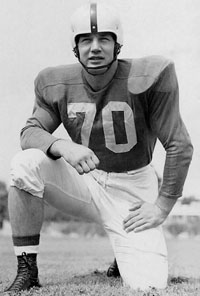
Bob Gain
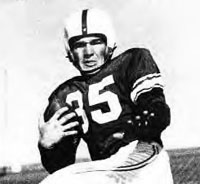 Billy Vessels |
|
November 17, 1962: Alabama @ Georgia Tech
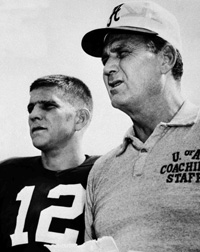
Bear Bryant with QB Pat Trammell

Bobby Dodd

Joe Namath
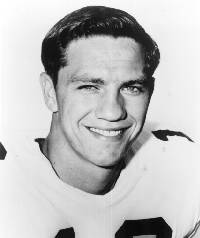
Billy Lothridge |
In 1961, Alabama defeated Georgia Tech in Birmingham 10-0, part of the Tide's 11-0 national championship season. However, one play from the Tech game had ramifications for the following season and beyond. In Q4, Tech punted. Billy Richardson signaled for a fair catch. Tech's Chick Graning, part of the coverage team, relaxed after Richardson made the fair-catch signal. Darwin Holt, who did not know that Richardson was making a fair catch behind him, drove his elbow up under Graningís face mask just as the whistle blew. Graning fell unconscious on the field. An official close to the play did not throw a flag for unnecessary roughness.
Graning suffered a fracture of the facial bones, five missing front teeth and the remainder of the front teeth broken, fracture of the nasal bone, fracture of the right maxillary sinus and sinus filled with blood, fracture of the bone beneath the right eye, and a cerebral concussion. Atlanta reporters claimed the hit was dirty and deliberate. Graning's father told the media: "I believe Bryant is encouraging such tactics." Holt received hate mail and death threats. He privately drove to Atlanta to visit Graning in the hospital and apologize.
Tech coach Bobby Dodd wanted Bryant to suspend Holt for several games. Bryant refused, taking the position that the Atlanta media were not going to dictate how he handled his players. Dodd was livid over Bryantís unwillingness to correct the situation. It would be years before the two former friends buried the hatchet.
Watch highlights of the 1961 game narrated by Bear Bryant. He doesn't mention the controversial play. The teams met again in Atlanta the following season. Tech entered the game with a 5-2-1 record. #1 Alabama was 8-0 and sporting a 26-game non-losing streak. Bama's last defeat had been at Tennessee 20-7 on October 15, 1960. The Tide also played a 3-3 tie against Texas in the Bluebonnet Bowl at the end of that season.
With a record Grant Field crowd of 52,971 on hand, Bryant put sophomore QB Joe Namath in a shotgun formation, a tactic that Tech went to for its QB Billy Lothridge late in the first quarter. Yet neither formation produced much offense. Bama held Lothridge to his poorest day ever, 49y passing and only four rushing. Namath fared little better.
Lothridge put Alabama in a hole in the first quarter when he punted out of bounds on the five. When Tech regained the ball at its 42, Billy completed three straight from the "short punt formation" to the 15. However, Butch Wilson's interception stopped the drive.
The home team's only touchdown was set up by FB Mike McNames's second quarter interception which he returned to the Tide 14. Two plays later, McNames had the honor of scoring the touchdown on a 9yd smash over right guard.
The furthest Bama drove in the first half was the Tech 49, where Jack Hurlburt was inches short on fourth down on the last play of the opening period.
Tech again marched down the field to a first down at the 12. After several plays resulted in losses, Lothridge was short on a 43y FG attempt.
Bama continued to flounder in the second half, thanks in large measure to two more interceptions thrown by Namath. However, Bryant's defense stifled the Yellow Jackets until Lothridge made a crucial mistake. Back to punt, he accidentally touched his knee down on his nine while fielding the snap. It took four plays, but Cotton Clark ran in from the two to make it 7-6. Bryant went for two. Hurlbut ran around right end, but McNames and T Ed Griffin stopped him at the one.
The visitors had one more chance, driving to the 14. Instead of setting up a winning field goal, Bryant called for Namath to pass. However, DB Don Toner, from Bessemer AL, intercepted the deflected ball with 1:05 left.
When they met at midfield, Dodd told Bryant: "I believe that was the cleanest game I've ever seen. What do you think, Coach?" Bryant replied, "It certainly was. But I didn't expect anything different." Dodd gushed to the media: "Today's was the greatest individual victory ever won by a Georgia Tech football team." |
October 16, 1955: Auburn @ Georgia Tech
The Auburn Tigers/Plainsmen made their annual trip to Atlanta – at least annual for the eleventh straight year – to play Bobby Dodd's Georgia Tech Yellow Jackets. The previous ten visits had all resulted in losses. Add a 27-0 loss at home in 1944, a 15-0 defeat at Montgomery in 1942 ( Auburn fielded no team in '43 due to World War II), and a 28-14 whipping in Atlanta in 1941, and you have a 14-game losing streak. The last War Eagle win had been 16-7 at Tech in 1940.
After two rebuilding years, Coach Ralph "Shug" Jordan had compiled a record of 17-6-2 in the last two plus seasons and 24-19-2 overall. Of course, he had yet to savor victory over SEC-rival Tech. The '54 contest had been competitive, 14-7 after 27-7, 33-0, and 36-6 drubbings. The 5th-ranked 4-0 Jackets were favored again over the 17th-ranked Tigers. Dodd's men had bested Miami (FL) and SMU in the friendly confines of Grant Field and Florida and LSU on the road. Auburn also claimed a victory over the Gators as well as one over U.T. Chattanooga and a tie with Kentucky.
Auburn scored first late in Q1 after a 29-yard pass to E Jerry Elliott from junior QB Howell Tubbs. Alton Shell ended the 61-yard drive from the 7 as FB Joe Childress faked up the middle. As was usually the case in that era, a regular did the kicking. For Auburn it was Childress who converted the PAT. Tech answered with a Q2 TD on a sneak by its QB Wade Mitchell, but his PAT missed to leave Auburn ahead at the half. |
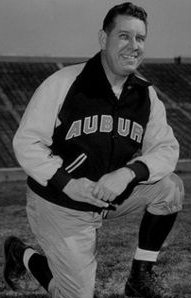
"Shug" Jordan |
Early in Q3, Tech took the lead for the first time on a 59-yard burst by HB George Volkert. A bad snap prevented the conversion.
The visitors started their winning drive in Q3 and finished it in the final period. Tubbs' passes ate up 71 of the 80 yards. E Jimmy "Red" Phillips, who paired with Elliott to form one of the best two-way duos in the nation in those limited substitution days, had receptions of 7, 12, and 20. The 12-yarder came on fourth and four at Tech's 31. The last put the ball on the 5, from where Childress rammed to the one and Tubbs sneaked it in. Childress' PAT made the final score 14-12.
After visiting Atlanta four more years – winning two and tying one, Auburn finally hosted the Jackets in Birmingham in 1960 and came away with a 9-7 win. Auburn continued its rivalry with Tech long after the Atlanta school left the SEC following the 1963 season.
October 31, 1936: Minnesota @ Northwestern
Halloween is meant to be spooky but not until nightfall. For the visiting Golden Gophers, this Halloween turned scary in the daylight and cost them their 28-game unbeaten streak. Hundreds of sports writers converged on Evanston along with nine radio hookups, including CBS and NBC.

Bernie Bierman |
Minnesota's last loss had been the final game of 1932 to Michigan 3-0 in Bernie Bierman's first year as coach after arriving from Tulane. 1933 brought the strange record of 4-0-4. Then the Gophers were 8-0 in both 1934 and 1935 and consensus national champions both years (the United Press poll, the Helms Athletic Foundation, the College Football Researchers Association, and the National Championship Foundation). Because the Western Conference (Big Ten) barred its teams from post-season play, the Gophers had not been afforded a chance to test their mettle against teams from the West and South.
Bierman's four 1936 victims included Washington on the road, Nebraska, Michigan, and Purdue. The quartet had managed to score only 7 points. The Wildcats of second-year coach Lynn "Pappy" Waldorf were likewise 4-0, defeating Iowa, North Dakota State, Ohio State, and Illinois. Waldorf had concocted a special "read and react" defense to counter the Gophers' powerful offense, which had totaled 59 points the last two weeks. Pappy's conception employed elements of what today would be called the zone blitz. |
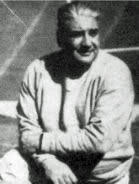
Pappy Waldorf |
|
The first sellout crowd in six years at Dyche Stadium (48,347) sat through rain which immediately impacted the game. On its second play, Minnesota ran one of its single wing staples, the "buck lateral." The snap goes directly to either the FB or TB who runs straight ahead but gives the ball to the spun-around QB (actually the blocking back) who pitches it to the TB/FB (whoever didn't receive the snap) running around end. FB Andy Uram broke clear on the play and was running for a TD when he slipped at the NU 23. MU messed up a fake FG and got nothing from the drive. Waldorf's D had no further lapses, and the half ended scoreless.
Near the end of Q3, Northwestern finally mounted a drive, but Don Geyer missed a 19-yard FG. Then came back-to-back breaks that enabled the Wildcats to take the lead. First, Minnesota fumbled on the ensuing possession and Dewitt Gibson, NU's 225-pound T, recovered on the Gopher 13. On first down, HB Don Heap recovered his own fumble for a two-yard loss. Then came break #2. Heap regained the two yards on the next play but the officials stopped play and gathered around the pileup. Minnesota was penalized to its one for unnecessary roughness. |
The Gophers didn't concede the final yard. Geyer gained nothing on a plunge as G Bud Wilkerson led the staunch D. After the officials moved the ball as far as you can for the change of quarter, 163-pound FB Steve Toth tried the middle but met a stonewall. Finally, on third down, Northwestern's front opened a hole for Toth to tumble untouched into the end zone. When Minnesota blocked the extra point, NU led 6-0.
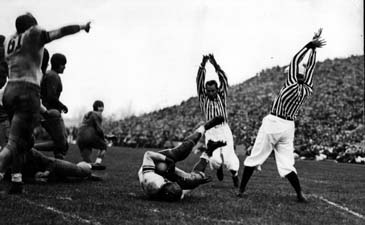
Toth falls into the end zone for the go-ahead TD.
In the last 14 minutes, the Wildcats had to repel two Gopher drives and one trick play.
- The first Gopher thrust ended on the NU 39 when Northwestern recovered an errant lateral.
- The next onslaught reached the 17 but ended on an incomplete pass in the end zone on fourth down.
- Minnesota had one more trick up its sleeve after receiving a punt on its 20 with less than five minutes to play. Uram smashed over RT and, as he was hit after only five yards by Fred Vanzo, NU's 215-pound QB, lateraled to Rudy Gmitro who raced downfield behind a wall of blockers. When the last man in his path had been leveled, Gmitro appeared headed for the tying TD when Vanzo ran him down from behind. Years later, Waldorf still didn't know how Vanzo, who had played the entire game, got up off his knees and caught the speedier Gmitro.
Despite being outgained 351-150 (including return yards), NU prevailed. On Monday, Northwestern students celebrated by striking classes to dance and prance about campus.
November 21, 1931: Southern California @ Notre Dame
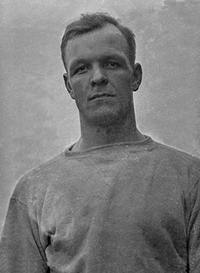
"Hunk" Anderson |
Notre Dame rode a 26-game unbeaten streak into what was becoming its annual clash with the Trojans. After going 19-0 in 1929 and 1930, the Fighting Irish had been tied by Northwestern 0-0 in the second game of the '31 season. The last defeat had been at the hands of the Trojans in the last game of 1928, 27-14. Irish success had continued unabated after the loss of inspirational coach Knute Rockne in a plane crash earlier in the year. The transition had been seamless under Heartley "Hunk" Anderson, "Rockne's faithful assistant." ND had played the 1927 and '29 USC games at Soldier Field in Chicago but now hosted the Trojans at their new 54,000-seat stadium, whose construction in 1929 forced Rockne's men to play and win all nine of their games on the road.
USC was putting together an exceptional season itself with six straight victories. The team craved revenge for what had happened the year before in L.A. The 1930 Trojans had gone into the game with an 8-1 record, outscoring opponents 382-39 with five shutouts. Yet Notre Dame had laid a whipping on them. En route to South Bend on the "Trojan Special," USC coach Howard Jones told reporters: "There is every reason to believe that the team we buck up against Saturday is much stronger than the one which trounced us 27-0 last year." However, Jones also said during a stopover in Hutchinson KS for a workout, "We are in excellent shape physically, if that means anything, and we are ready to give them the best we have." The Associated Press article on the workout stated: "Thirty-four squad members spent nearly two hours [in a steady drizzle] on a local athletic field today in scrimmage, passing and punting. A crowd of 2,000 met the Californians and escorted them to the gridiron. FB Gaius [Gus] Shaver was a spectator owing to a slight foot infection that is not expected to keep him benched at South Bend Saturday." |
Note: From the beginning of the rivalry in 1926, both the USC and ND coaches scheduled daily workout stops on the cross-country trip to the annual game as an opportunity to show off their squads and meet with local reporters.
Despite their preparation, the Trojans fell behind 14-0 as Steve Banas and Marchy Schwartz scored TDs. The home team retained that edge heading into the last stanza. As a result, Anderson removed most of his regulars. The subs were fresh and considered by many the equal of most first teams across the nation. However, the move proved to be a major mistake.
Shaver, bad foot and all, scored twice, and only a missed PAT kept the Trojans behind, 14-13. Because of the rules in effect at the time, Anderson couldn't reinsert his starters. Players who left the field could not return until the next quarter. USC drove into Irish territory still again, and Johnny Baker, who had missed an extra point earlier, booted a 23-yard FG with one minute left to win 16-14. |
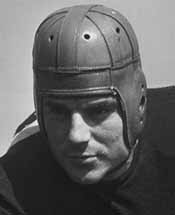 Marchy Schwartz |
The USC squad thoroughly enjoyed the long train ride home. At one stop, the boys from sunny California started a snowball fight that even Coach Jones joined in. The AD, assistant coaches, and players were all targets. When the team reached the City of Angels, the players, outfitted with bowler hats by a Chicago haberdashery, met the mayor at City Hall and then rode through a throng of 300,000 in a victory parade.
The game had been broadcast live on radio across the country. Within a few days of the victory, Angelenos could see the film of the game as part of a double feature at Loews State, the top theater in the city. Local sportswriter Braven Dyer did the narration. When it quickly became clear that people were coming for the football game, the Hollywood flick was dropped. The run broke house records at Loews.
The 1931 USC-ND game is considered a turning point for both schools. The Trojans won their second national championship in four years under Jones and would win two more before his premature death in 1941. On the other hand, Notre Dame started a downward slide as more of Rockne's players graduated each year. Anderson compiled a 16-9-2 record in three years. It wasn't until Frank Leahy returned to his alma mater in 1941 that ND returned to national prominence.
Reference: Football Feuds: The Greatest College Football Rivalries, Ken Rappoport & Barry Wilner
Streak Busters Archive | Top of Page |
November 13, 1982: Southern Methodist @ Texas Tech
|
First-year coach Bobby Collins had yet to lose at SMU. His Mustangs, ranked #2 in the AP poll behind Georgia, took a 9-0 record and a 13-game winning streak, the nation's longest, into Lubbock, where they had not won since 1968. A win over the 4-5 Red Raiders would clinch a tie for the Southwest Conference championship, which they had won outright in 1981.
SMU's "Pony Express" senior tandem of Eric Dickerson and Craig James had electrified the Southwest Conference. Dickerson was in the process of amassing 4,450 yards for a new conference record for a career. James piled up a mere 3,742 yards. They both had a score to settle with Tech since the Raider D, led by All-American DT Gabe Rivera, was the only one in the SWC to hold the duo scoreless in previous meetings.
The two quickly ended that streak in Q1 when Dickerson scampered 28yd for a TD behind James' clearing block. But Tech fought back to take a 10-7 lead on a FG by Ricky Gann and a 1yd sneak by QB Jim Hart.
The Mustangs then galloped 76yd to retake the lead on Dickerson's 6yd sweep which started out with him dribbling the pitchout. LB Gary Moten intercepted Hart's pass on the next series, and SMU marched to
the Tech 23, from where Jeff Harrell kicked a 39-yard
FG with the aid of a 33 mph wind at his back to give the visitors a 17-10 halftime lead.
James broke his own scoreless streak against the Raiders by running 16yd to extend the lead to 24-10. Tech stormed back to tie on Hart's 16yd pass and a 71yd run by TB Anthony Hutchison, whose 206yd exceeded the Express' combined total. With 4:23 remaining, Harrell's FG put SMU back on top 27-24. Tech then mounted a 71yd drive that ended with the Mustang D stuffing Hutchison on 3rd-and-1 at the 10. So Tech coach Jerry Moore opted for a tying FG by Gann with only 0:17 left.
The ensuing kickoff produced the play that will live as long as there are SMU fans to recall it. Collins called for a trick play that the team worked on every Thursday at practice. "It never worked in practice," admitted WR Bobby Leach afterwards. Tech squibbed the kick to the 9 where S Blane Smith bobbled the ball for several seconds, which had the unintentional but welcome effect of enticing the rushers to converge on him. Finally coralling the ball, he threw it to the sideline to Leach who raced untouched 91yd for the winning TD with 0:04 remaining.
Dickerson said afterwards, "I always believed in miracles ... I'm going to go to church tomorrow ... I looked all over for flags ... it was just a miracle." James: "I already had my mind set on 10-0-1. All of my life, I'd always have remembered that one tie." Moore was still in a state of disbelief 30 minutes after the game. "This is one of the hardest experiences in the dressing room after a game I've ever had to go through," he said. |
Aftermath
- The following week, Arkansas tied SMU 17-17 in Dallas to knock them to #4 in the final regular season poll. The Ponies represented the SWC in the Cotton Bowl, where they defeated Pittsburgh 7-3 to finish second in the final AP poll to 11-1 Penn State, which defeated #1 Georgia in the Sugar Bowl.
- The winning 91yd return, which presaged the "Music City Miracle" employed by the Tennessee Titans to win a playoff game against Buffalo in 2000, lasted as the "Play of the Year" for exactly one week. That's because the most famous play in college football history occurred on November 20, 1982 when California met Stanford. Need I say more?
- SMU's football program received the "death penalty" from the NCAA following the 1986 season because of repeated violations over an extended period, including the Pony Express years. The school has still not recovered from the two-year shutdown of its football program, achieving only one winning season since (6-5 in 1997).
- The name of the Texas Tech coach may be familiar to you. Jerry Moore left Lubbock in 1987 after five losing seasons. In 1989, he took over at Appalachian State, building the program to the point where it has won three straight I-AA championships (2005-7) and upset Michigan in 2007.
|
CONTENTS
1905:
Michigan @ Chicago
1931: Southern California @ Notre Dame
1936: Minnesota @ Northwestern
1947: Southern @ Grambling
1950: Oklahoma vs Kentucky
1955: Auburn @ Georgia Tech
1962: Alabama @ Georgia Tech
1982: SMU @ Texas Tech
Streak Busters Archive - II
Golden Football Magazine
Top of page
|
|




